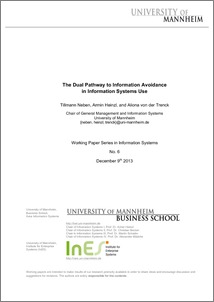|
The dual pathway to information avoidance in information systems use
Neben, Tillmann
;
Heinzl, Armin
;
Trenck, Aliona von der
![[img]](https://madoc.bib.uni-mannheim.de/style/images/fileicons/application_pdf.png)  Vorschau |
|
PDF
Dual_Pathway_Neben_Heinzl_vd_Trenck.pdf
- Veröffentlichte Version
Download (889kB)
|
|
URL:
|
https://madoc.bib.uni-mannheim.de/35208
|
|
URN:
|
urn:nbn:de:bsz:180-madoc-352086
|
|
Dokumenttyp:
|
Arbeitspapier
|
|
Erscheinungsjahr:
|
2013
|
|
Titel einer Zeitschrift oder einer Reihe:
|
Working Paper Series in Information Systems
|
|
Band/Volume:
|
006
|
|
Ort der Veröffentlichung:
|
Mannheim
|
|
Sprache der Veröffentlichung:
|
Englisch
|
|
Einrichtung:
|
Außerfakultäre Einrichtungen > Institut für Enterprise Systems (InES)
Fakultät für Betriebswirtschaftslehre > ABWL u. Wirtschaftsinformatik I (Heinzl 2002-)
|
|
MADOC-Schriftenreihe:
|
Area Information Systems and Institute for Enterprise Systems > Working Paper Series in Information Systems
|
|
Fachgebiet:
|
004 Informatik
600 Technik
|
|
Freie Schlagwörter (Englisch):
|
information avoidance , eye-tracking , emg , information pathologies , human information avoidance , EDA
|
|
Abstract:
|
This article develops an explanatory model of information avoidance behavior from extant theory and examines its hypotheses using psychophysiological methods. It integrates existing but partially conflicting explanations into a coherent positivist model based on Coping Theory. The existence of two distinct but interlinked causal pathways to information avoidance will be outlined. Both pathways are cause by defects in the information quality. The first pathway is grounded on being threatened by the information’s inconsistency. The second pathway is based on being distressed by the information’s complexity. Due to the involvement of cognition as well as affect, the usefulness of traditional measurement methods alone is deemed to be limited. Thus, we will draw upon recent advances from NeuroIS research in order to integrate psychophysiological measures into an extended, triangulated measurement protocol. This article intends to contribute to this special issue in three ways. First, it shapes a theoretical model for studying information avoidance which has received little attention in IS research. Second, it exemplifies the derivation and instantiation of a NeuroIS measurement model and the selection of appropriate NeuroIS methods for scrutinizing the theoretical information avoidance model. Third, based on the evidence of an experiment, it provides guidelines for how to conduct eye-tracking, pupillometry, and facial electromyography measurements as well as how to subsequently derive meaning from the initial data collected.
|
 | Dieser Eintrag ist Teil der Universitätsbibliographie. |
 | Das Dokument wird vom Publikationsserver der Universitätsbibliothek Mannheim bereitgestellt. |
 Suche Autoren in Suche Autoren in
Sie haben einen Fehler gefunden? Teilen Sie uns Ihren Korrekturwunsch bitte hier mit: E-Mail
Actions (login required)
 |
Eintrag anzeigen |
|
|



 Suche Autoren in
Suche Autoren in